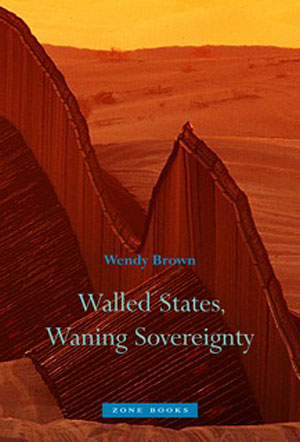
The 1989 fall of the Berlin Wall was an internationally celebrated event, and was also the occasion for numerous proclamations, across the political spectrum, of a dawning unbordered world. Yet, since that date, more than two dozen new walls have been built at or near nation-state boundaries. Many more nation-state walls are in the planning stages.
Why? Why are walls proliferating in an era of unprecedented global connectedness and the emergence of postnational constellations such as the European Union? And why these visible, physical barricades of concrete, steel, and barbed wire when threats to the nation today are so often miniaturized, clandestine, dispersed, or networked? What are these walls doing, pretending to do, projecting or symbolizing?
Walled States, Waning Sovereignty locates the recent spate of wall building in the context of waning nation-state sovereignty. I specify this context as a “post-Westphalian,” epoch, one in which nation-states remain important world actors but their sovereign capacities are eroded by a host of transnational flows—people, capital, ideas, goods, violence, and political and religious fealty.
The contemporary proliferation of walls, I argue, is both a symptom of and specific reaction to this condition—but it does not solve the problem generating it.
The book draws on classical and contemporary political theories of state sovereignty in order to understand how state power and national identity persist amid its decline. I examine both state needs for legitimacy and the popular desires that incite contemporary wall building.
The new walls—dividing India from Bangladesh, Israel from Palestine, South Africa from Zimbabwe, Sunni from Shi’ite, North America from Mexico, Central and South America—consecrate the broken and porous status of boundaries they would seem to contest. They also signify the ungovernability by law of a range of forces unleashed by globalization.
Often, these walls amount to little more than expensive theatrical props: they are frequently breached, they frequently intensify the problems they aim to address, and often blur the distinction between law and lawlessness they are intended to represent.
But if today’s walls fail to resolve the conflicts between globalization and national identity, they nonetheless project a striking visual image of sovereign power. The new walls address human desires for sovereign order, for containment and protection in a world increasingly without these provisions. Walls also respond to the wish for political horizons and collective identity even as horizons recede and national identity is diluted in an ever more globally integrated and miscegenated world.
Walled States, Waning Sovereignty emerges from several decades of politically engaged scholarship.
I am a political theorist by vocation, which means that my thinking about the world is refracted through my training in the history of political thought. And I focus on specific contemporary phenomena—from the involutions of finance capital to the operation of identity-based social movements to the revitalized importance of religion in politics.
So my work always involves thinking through contemporary political problems at a theoretical level, often informed (as this book is) by the some of the most powerful political thought from the past—e.g., Hobbes, Schmitt, Locke, Marx—and also by contemporary political theory.
I came to this particular project through three concerns:
First, I was engaged with the scholarship on the contemporary predicament of nation-states losing their sovereign status, that is, losing the autonomous powers of jurisdiction, order, law and protection associated with the idea of sovereignty. Many philosophers, geographers, political scientists and legal scholars are working on this problem, and it was something I was trying to think through in my teaching and research.
Second, I was trying to understand why hundreds of millions of dollars were being poured into buttressing and extending the U.S.-Mexico border wall when each new fortification “failed”—produced an intensification in the drug and migrant smuggling industry, generated new border crossing routes through dangerous desert journeys, tunnels under the wall or boats around it, and added more generally to the organized crime and violence at the border.
Third, as I became aware of more and more border walls going up in the 1990s and 2000s, I was struck by the peculiarity of this development. We live in a time in which the most potent threats and weapons are biochemical and drone warfare, internet and phone hacking, suicide bombing, global climate change, the vicissitudes of finance capital, transnational organized crime. None of these can be significantly intercepted or deterred by large, long physical land barricades. So what is the point of these walls? What are they aimed at or achieving? Why do so many nations want walls now?
Eventually, these three concerns came together to produce the argument of this book. I begin thinking about the walls as failed performances of nation-state sovereignty, performances that projected an imago of sovereignty when sovereign power can no longer be realized on the ground. I developed appreciation of the work of political legitimation and consolation the walls are doing—work that is quite different from actually repelling the immigration, drug and weapon smuggling, or terrorism that incites their building.
The first few pages of Chapter One take the reader on a visual and textual tour of some of the new walls:
Of the new walls striating the globe… best known are the United States-built behemoth along its southern border and the Israeli-built wall snaking through the West Bank, two projects that share technology, subcontracting, and also reference each other for legitimacy. But there are many others. Post-apartheid South Africa features a complex internal maze of walls and checkpoints and maintains a controversial electrified security barrier on its Zimbabwe border. Saudi Arabia recently finished constructing a ten-foot-high concrete post structure along its border with Yemen, which will be followed by a wall at the Iraq border (which in turn Saudis say may be followed by walling their whole country). To deter refugees from its poorer neighbors, to stake its side in a land dispute, and to suppress the movement of Islamic guerillas and weapons across its Pakistan border, cruder barriers have been built by India to wall out Pakistan, Bangladesh, and Burma and to wall in disputed Kashmir territory. The crudeness should not deceive: India has mined the land space between double layers of barbed and concertina wire along the Indo-Kashmir border. Also in the context of a land dispute but officially built in the name of interdicting “Islamic terrorists,” Uzbekistan fenced out Kyrgyzstan in 1999 and Afghanistan in 2001 but Turkmenistan is now fencing out Uzbekistan. Botswana initiated the building of an electric fence along its border with Zimbabwe in 2003, ostensibly to stop the spread of foot-and-mouth disease among livestock but aimed at interdicting Zimbabwe humans as well. In response to the south Thailand insurgency and to deter illegal immigration and smuggling, Thailand and Malaysia have cooperated to build a concrete and steel border wall. There is the wall between Egypt and Gaza, brought to the world’s attention when it was breached in January 2008 by Gazans seeking food, fuel and other domestic goods. Iran is walling out Pakistan. Brunei is walling out immigrants and smugglers coming from Limbang. China is walling out North Korea to stem the tide of Korean refugees, but, parallel to one section of this wall, North Korea is also walling out China.
There are also walls within walls: Gated communities in the United States have sprung up everywhere but are especially plentiful in southwestern cities near the wall with Mexico…
This is not a book that aims to shape policy (except perhaps, to reveal the absurdity of investing so much money, labor, materials, and hope in nation-state wall building at this juncture in history).
Rather, it is a critical investigation of the relationship of sovereignty and walling in our time. My purpose is to open up this relationship for readers: to reveal features of walling and the clamor for walling that aren’t on the evening news.
In contrast to arguments for and against walls based on their political acceptability or technical efficacy, I am offering a less literal way of “reading” border walls and the contemporary desire for them.
I also hope to invite readers into the project of thinking theoretically and politically about the problem of waning nation-state sovereignty. What happens when this 300-year old political form is fading but has not yet been replaced? What kind of global inter-regnum are we in? What kinds of political anxieties and fears are generated by this condition and what reactive political formations issue from such anxieties and fears?
To this end, the last chapter makes a turn to psychoanalysis, and more specifically, to psychoanalytic theories of “defense formation” and of sovereign religious power. I draw some speculative links between the conditions producing psychic defense formations and desires for barricaded nations in an increasingly unhorizoned and porous political landscape. I also consider the possible overlap between conditions generating desires for an all-powerful protective deity (the desire for religion) and those generating desires for walled nations.
All of these speculations are open-ended and non-empirical. My aim is to provoke reader reflections on some of the political predicaments of our time, not to close my inquiry with a strong or definitive position.


Wendy Brown is Class of 1936 Professor of Political Science at the University of California, Berkeley where she is also affiliated with the Department of Rhetoric and the interdisciplinary graduate programs in Critical Theory and in Women, Gender and Sexuality. Her work has been translated into more than fifteen languages.
Besides Walled States, Waning Sovereignty, featured in her Rorotoko interview, her books include Is Critique Secular? (co-authored, 2010), Regulating Aversion: Tolerance in the Age of Empire and Identity (2006), Edgework (2005), Left Legalism/Left Critique (co-edited, 2002), Politics Out of History (2001), States of Injury: Power and Freedom in Late Modernity (1995), and Manhood and Politics (1989).